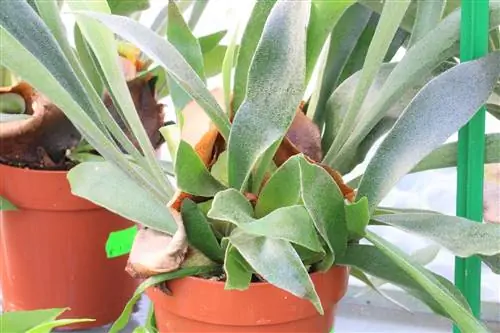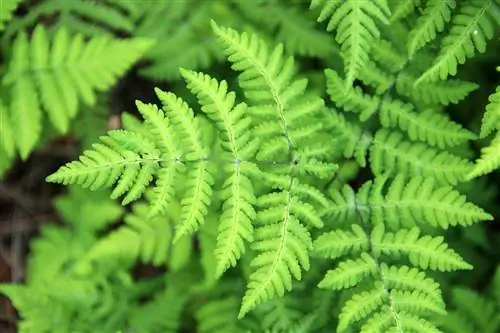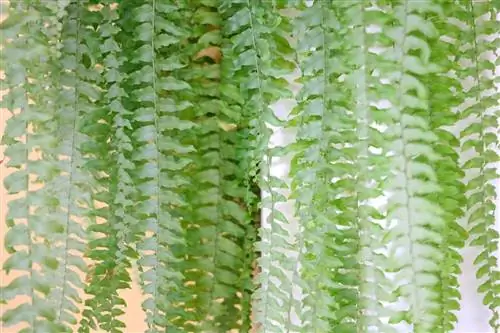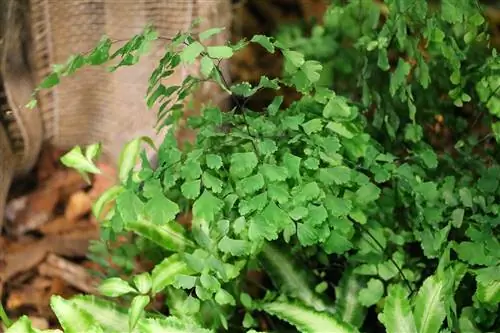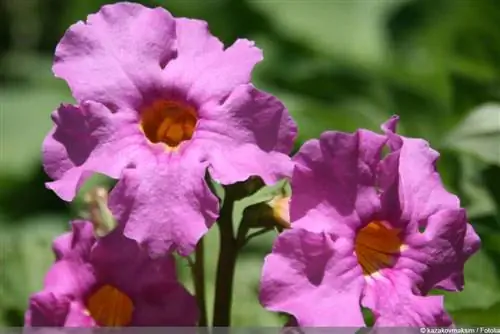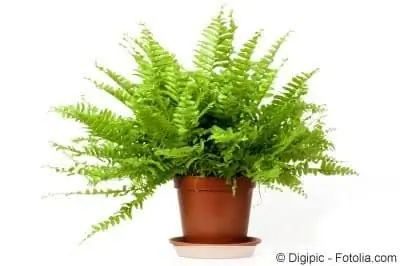- Author admin [email protected].
- Public 2023-12-17 03:39.
- Last modified 2025-06-01 06:48.
The staghorn fern or Platycerium is an interesting plant. The two different leaf shapes and the substrate-free cultivation also give it an exotic look. However, in order for it to maintain its unusual appearance and thrive, it requires special care - which can also be managed by beginners.
Round leaves at the base, leaves like deer antlers at the top and free roots - the staghorn fern is an eye-catcher. Since it does not rely on a substrate, it can also be used to create decorative creations. Of course, this only works if the unusual plant receives the right care. And the right surface also plays a role. Hobby gardeners can get helpful tips and the necessary knowledge here:
Location
The staghorn fern or platycerium is a plant that grows directly on tree trunks and at surprising heights in its areas of origin. It receives plenty of light here, but is protected from direct sun by the treetops. In the house, this light is best created on windows facing east and west. A south-facing window is also suitable if it is shaded during midday. Or the staghorn fern is at a distance - i.e. not directly at the glass. Platycerium also likes it warm. The ideal temperature is 20 to 25 °C, below 15 °C it becomes critical for the exotic plant. Pay attention to the humidity, especially in a warm location. The higher the better. To avoid having to keep the entire room moist, the plant should be sprayed frequently.
Substrate
Platycerium does not grow on the ground, but on tree trunks. The roots hold on to their bark. The staghorn fern does not need any substrate. Instead, it can be tied to a piece of bark depending on its size. A mixture of coconut fibers and sphagnum moss serves as a base between the plant and roots. In this form the plant can also be hung freely in the air.
If you prefer to put the fern in a pot, you can do that too. However, instead of your pot, a shallow bowl or hanging basket is a better choice. This requires substrate that is mixed in equal parts peat and sphagnum. Orchid soil is also a suitable substitute.
Tip:
An environmentally friendly alternative suitable for the staghorn fern is coconut fiber or bark compost.
Pouring
If Platycerium is kept without a substrate, the usual watering is of course not possible. Instead, the plant base is immersed in water until it is saturated. During the growth period, additional spraying of the leaves - preferably daily - is recommended. When cultivating in the substrate, you can water or dip from below and without contact with the leaves; the latter extends the distance until the next watering. This should be done when the substrate or base is almost completely dry. In winter, the frequency and amount of watering can be reduced even further. Pot, bark or spraying - in any case, the staghorn fern needs low-lime, soft water. Rainwater is the best choice, stale tap water is also tolerated.
Tip:
Platycerium only needs water when the leaves appear light and thin. If they are tight and heavy, there is still enough water in them.
Fertilize
In the wild, the staghorn fern fertilizes itself. The large, round leaves at the base catch parts of plants and insects that fall from above. Here the material rots and is absorbed by the fern. Of course, this cannot happen when cultured on bark or in a bowl. The missing supply is replaced by a commercially available liquid fertilizer, which is added to the water every three to eight weeks. Bar on the bark the doses can be given at close intervals, in the loose substrate mixture in slightly larger ones.
Replacing and repotting
If the staghorn fern becomes too big for its base and is therefore unstable, it needs to be moved:
- The binding material, such as thread or wire, is cut.
- Then the roots are loosened as carefully as possible and the base is replaced with a larger one.
- The culture in the substrate is also refreshed if the Platycerium is no longer stable.
- Even if the situation is good, the mixture of moss and fibers should be completely replaced about every three to five years.
Intersection
The round base leaves of the fern become dry, thin and translucent over time - even with perfect care. This is not a cause for concern as long as it replaces the plant. Once dried, they can be carefully cut or torn off. Apart from this, no waste is necessary. Only damaged or dried plant parts are removed.
Propagation
The plant reproduces through offshoots. The secondary shoots form on the base of the plant. Once they have formed roots, you can carefully remove them. The cuttings are placed in pots with peat moss and watered thoroughly. The staghorn fern can also be propagated by sowing. To do this, remove the brown spores from the undersides of the leaves and sow them in well-watered peat moss. The earth is then covered with a fine layer of sand. The seed containers should be placed covered with glass in a dark location. During cultivation, the seedlings require a room temperature of 25 °C. Staghorn fern generally prefers high humidity, small water evaporators support the desired climate. The root ball should be dipped once a week so that it can soak up evenly.
Wintering
Overwintering the staghorn fern is very easy because the plant simply remains in its usual location. However, fertilizing is stopped and watering is adjusted to the reduced need. Cooler wintering is also possible. The Platycerium should never be colder than 15 °C.
Pests, diseases and care errors
The staghorn fern hardly suffers from diseases and pests if it is cared for correctly. If it is in a poorly ventilated place and is watered too thoroughly, mold can develop. The areas affected by the fungus must then be removed and treated with a fungicide. Fresh air and appropriate watering prevent and provide relief.
If there are brown discolorations on the leaves, especially at the tips of the leaves, the Platycerium is being kept too dry. Among the pests, only scale insects are occasionally interested in the staghorn fern. They can be removed with a water jet that is not too hard or, in hard cases, brushed with spirit and then rinsed off.
Tip:
Regular cleaning of the leaves is a preventive measure against diseases and pests. They are rinsed and either shaken off briefly or gently air-dried with a hairdryer.
Frequently asked questions
Is the staghorn fern poisonous?
Platycerium is only slightly toxic and is usually not attractive to animals. They should still be kept out of the reach of children.
Why do staghorn fern leaves fade?
If the Platycerium has yellowish or light green leaves, this may be due to a location that is too bright or too dark. Direct sunlight causes the green to burn, dark shade breaks down chlorophyll. Checking the light and changing it accordingly will help.
What you should know about the staghorn fern in brief
In nature, the staghorn fern can be found in tropical rainforests on jungle trees up to 30 meters high. Like a bird's nest, it grows in forks of branches and feeds on dead plant remains. Its cover leaves are very decorative. As a houseplant, the staghorn fern can not only be cultivated in pots, it can also grow on a piece of cork or tree bark.
- The native fern is particularly suitable as a hanging plant.
- The hairy antler leaves are initially green and later turn brown. Their total length can be up to 80 cm.
- The jungle plant prefers a partially shaded to shady place as it cannot tolerate sun.
- Ideally, the room temperature should be a constant 20 °C in summer and 16 to 18 °C in winter.
- In winter it is enough to dip the plant ball every 10 days. It is recommended to add fertilizer to the irrigation water once a month.
- The staghorn fern is repotted every three years. In addition to pots, baskets and bowls of an appropriate size are also suitable for this.
- The planters are filled with a peat mixture or orchid soil.
- If the leaves of the fern hang weakly, this is a sign that the plant has not been watered enough.
- Rotting but also falling leaves indicate that too much has been watered.
- The leaves of the staghorn fern are never wiped off so that the vital hair is not destroyed.

